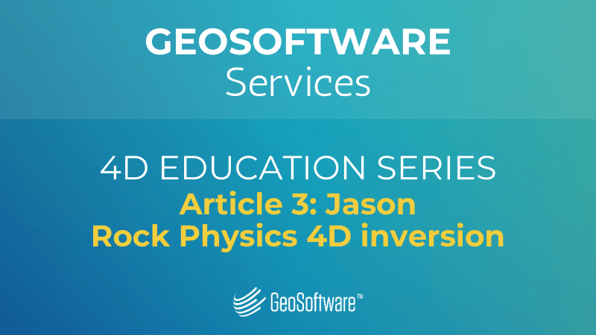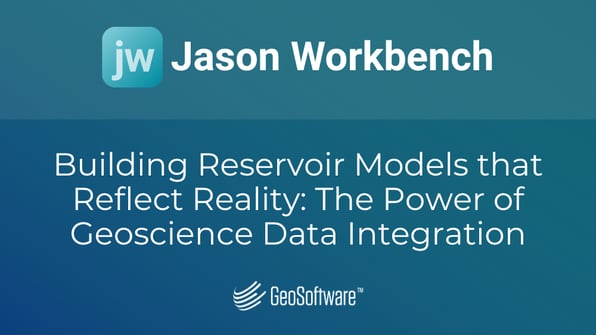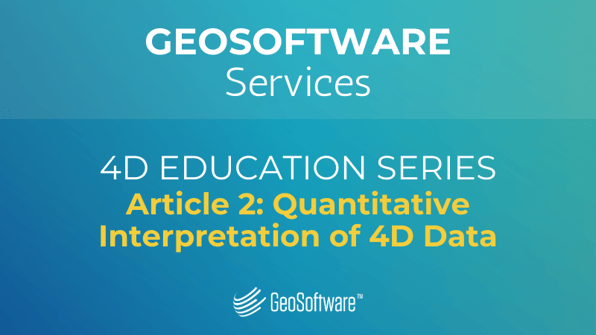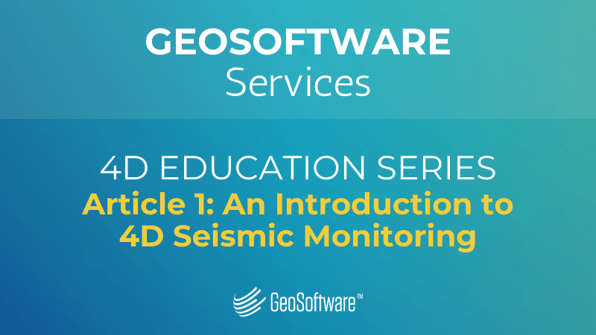
This is the third article of three series dedicated to a review of 4D seismic monitoring. The series describes how valuable 4D techniques can be achieved and realized through the application of GeoSoftware technology and associated services.
In the previous article, we highlighted the benefits of pre-stack 4D inversion in providing a quantitative estimate of the changes in elastic parameters caused by production and the impact of not using the correct 4D low-frequency model on those properties and the overall 4D interpretation. Different methods were introduced to update the 4D low-frequency methods.
In this article, we will discuss the GeoSoftware 4D capabilities in enabling a direct quantitative interpretation and discrimination of the pressure and saturation effects.
Direct inversion for petrophysical properties
The ultimate goal in quantitative seismic interpretation is to obtain an estimate of the special distribution of reservoir properties: porosity, clay content (Net-to-Gross), permeability, and water saturation. This could be achieved by performing the AVA/AVO geostatistical seismic inversion in a two-step process, where the first step is to invert the input data (seismic, well, geological prior information) for the elastic properties to generate realizations of elastic properties (Impedances and Vp/Vs ratio). Then, we use a process called co-simulation to estimate realizations of petrophysical properties (porosity, clay content, etc.) from the previously generated elastic properties via a statistical relationship.
Alternatively, we could invert directly for the petrophysical properties by including the appropriate rock physics model to forward calculate the elastic properties during the process of generating realizations of facies, porosity, clay content, and water saturation. The direct (one-step) inversion workflow is usually recommended if the final objective is an integration of multi-disciplinary data to assist in generating reservoir properties at the resolution of a static model. This would be followed by running numerical flow simulation and history matching.
The direct inversion reduces the uncertainty associated with the output model, and the uncertainty itself can be quantitatively assessed to determine the range of reservoir possibilities within the constraining data. Marquez et al. 2013, described this workflow combining geostatistical seismic inversion and rock physics modeling to obtain joint estimates of lithofacies, elastic, and reservoir properties in a single pass. Geological trend models were used as additional constraints on the prior geostatistical distribution of each lithofacies and continuous properties.

Figure 1: The direct inversion workflow provides a reliable estimation of the distribution of the reservoir properties and allows for capturing and quantifying the uncertainty associated with output models.

Figure 2: Vertical cross-section showing direct inversion reservoir properties: facies, porosity, clay content (Vclay), and water saturation driven over an offshore West Africa (after Marquez et al. 2013).
Direct inversion for pressure and saturation changes
Jason rock physics-based 4D inversion is a GeoSoftware-patented technology (RockMod 4D), which is an extension to direct inversion for petrophysical properties. RockMod 4D inverts all vintages simultaneously to predict the changes in the elastic properties that result from saturation and pressure changes. The engine starts by perturbing properties and facies to estimate the reservoir properties. Porosity, clay content, and water saturation are typically the primary properties being inverted. In the reservoir, permeability is computed from porosity using empirical relationships per facies. The base saturation is computed from the theoretical capillary functions (one per lithofacies). The base pressure is calculated from 1D pore pressure analysis. The expected changes in pressure and saturation are modeled from well logs and production data through rock physics modeling (RPM). The modeled probabilities for these expected changes are priors to the inversion. The priors for the base properties are defined by fitting data from the well logs. The monitor properties are the sum of the base and delta properties. Building and obtaining a reliable rock physics model (RPM) is a critical part of the rock physics inversion workflow. The RPMs are used during the inversion to go from properties to seismic via forward modeling. Synthetic of base and monitor honor the associated seismic vintages.

Figure 3: Results of water saturation from 50 realizations of rock physics 4D inversion over a case study from offshore Africa. We had two monitors, and you can notice the vertical details and how saturation changes are accurately predicted between base and monitor (top). Also, the contact movement is clear between the base and monitor sections. The lower image shows a stratal slice of saturation base, monitor, and differences. The yellow arrow refers to the approximate location of the slice. These results allowed the highlight areas of bypassed (dashed black lines), areas of compartments, and the permeability pathways. The results are used to improve the geological model, compared directly with reservoir prediction, and history matching data.

Figure 4: RockMod 4D engine offers multiple capabilities of facies modeling such as multi-level association and facies ordering and nested facies. These capabilities would be necessary for modeling certain reservoir depositions. Incorporating facies trends (1D, 2D or 3D) as a geological constraint is also possible.
Jason rock physics 4D inversion unlocks the quantitative information unavailable to traditional 4D inversions. It provides probabilistic outputs and facilitates capturing uncertainty by delivering scenarios of facies and reservoir properties (pressure and saturation changes) at a resolution necessary for geomodelling. It makes it easy to update models once new information is available, therefore tracking production-related changes or inefficient production or injection processes. Jason rock physics 4D inversion could also handle different data types including PP-PS and azimuthal seismic data.
A flexible 4D engine
Users could also perform RockMod 4D inversion in the elastic domain (Impedances and, Vp/Vs). The elastic RockMod 4D will invert all seismic vintages jointly to predict the changes in the elastic properties, but it does not require a rock physics model. The output volumes would be the change in impedances and Vp/Vs ratio. The simultaneous geostatistical inversion still perturbs the properties and facies jointly and would yield higher details (sub-seismic) realizations of facies and elastic properties. Those realizations of elastic properties could further be linked quantitatively to the changes in saturation, pressure, or temperature through calibrated rock physics models.
A time constraint that might exist for delivering a quick 4D interpretation or the need to quickly check the feasibility of the 4D project would make the elastic RockMod 4D a quick and sufficient inversion solution for such 4D interpretation.

Figure 5: A schematic of Jason's workflow for elastic RockMod 4D inversion.

Figure 5: Stratal slice of impedance changes from elastic RockMod 4D inversion. The study had three vintages (base and two monitors) over a Miocene field, offshore Africa. This study aims to quickly interpret the present 4D anomalies due to production. The results allowed for detailed highlighting of the water anomalies and gas cap anomalies.
Summary
Here are some takeaways from today’s article:
- Jason RockMod technology can directly invert the pre-stack seismic data for estimating the petrophysical properties and generate realizations of facies, porosity, clay content, and water saturation. Direct inversion is usually recommended if the final objective is an integration of multi-disciplinary data to assist in generating reservoir properties at the resolution of a static model, running numerical flow simulation, and eventually history matching.
- Jason rock physics 4D inversion (RockMod 4D) is an extension to the direct inversion of the RockMod technology, and it inverts all vintages simultaneously to directly estimate the changes in pressure and saturation. RockMod 4D unlocks the quantitative information unavailable to traditional 4D inversions and facilitates capturing the uncertainty by delivering scenarios of facies and reservoir properties at a resolution necessary for geomodelling.
- The RockMod 4D has a flexible setting where users can perform geostatistical 4D inversion in the elastic domain to generate high-detailed realizations of facies, P-impedance, and Vp/Vs ratio.
To learn more about how GeoSoftware's reservoir experts can help you with your next 4D project, visit our Services page.

AUTHOR: Mohammed Ibrahim, Global Services Manager
Mohammed has over 20 years of experience in the oil and gas industry, most notably in geostatistical seismic inversion, QI geophysics, 4D seismic, and azimuthal seismic analysis. He has a proven record in integrating large, multi-scale, multi-disciplinary data to characterize hydrocarbon reservoirs and build “what-if” scenarios for both exploration and production fields. Mohammed has worked globally with NOCs, IOCs, and super-major oil and gas companies in a wide variety of complex petroleum provinces in North and Latin America, the Atlantic margins, the Middle East, and Western Australia. Mohammed holds a Ph.D. degree in geophysics from Michigan Technological University, and he currently oversees the professional services function within GeoSoftware.




